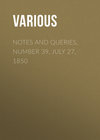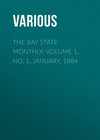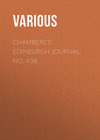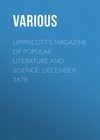Loe raamatut: «Notes and Queries, Number 39, July 27, 1850»
NOTES
ETYMOLOGY OF "WHITSUNTIDE" AND "MASS"
Perhaps the following Note and Query on the much-disputed origin of the word Whitsunday, as used in our Liturgy, may find a place in your Journal. None of the etymologies of this word at present in vogue is at all satisfactory. They are—
I. White Sunday: and this, either—
1. From the garments of white linen, in which those who were at that season admitted to the rite of holy baptism were clothed; (as typical of the spiritual purity therein obtained:) or,—
2. From the glorious light of heaven, sent down from the father of Lights on the day of Pentecost: and "those vast diffusions of light and knowledge, which were then shed upon the Apostles, in order to the enlightening of the world." (Wheatley.) Or,—
3. From the custom of the rich bestowing on this day all the milk of their kine, then called white meat, on the poor. (Wheatley, from Gerard Langbain.)
II. Huict Sunday: from the French, huit, eight; i.e. the eighth Sunday from Easter. (L'Estrange, Alliance Div. Off.)
III. There are others who see that neither of these explanations can stand; because the ancient mode of spelling the word was not Whit-sunday, but Wit-sonday (as in Wickliff), or Wite-sonday (which is as old as Robert of Gloucester, c. A.D. 1270). Hence,—
1. Versteran's explanation:—That it is Wied Sunday, i.e. Sacred Sunday (from Saxon, wied, or wihed, a word I do not find in Bosworth's A.-S. Dict.; but so written in Brady's Clovis Calendaria, as below). But why should this day be distinguished as sacred beyond all other Sundays in the year?
2. In Clavis Calendaria, by John Brady (2 vols. 8vo. 1815), I find, vol. i. p. 378., "Other authorities contend," he does not say who those authorities are, "that the original name of this season of the year was Wittentide; or the time of choosing the wits, or wise men, to the Wittenagemote."
Now this last, though evidently an etymology inadequate to the importance of the festival, appears to me to furnish the right clue. The day of Pentecost was the day of the outpouring of the Divine Wisdom and Knowledge on the Apostles; the day on which was given to them that HOLY SPIRIT, by which was "revealed" to them "The wisdom of God … even the hidden wisdom, which GOD ordained before the world." 1 Cor. ii. 7.1 It was the day on which was fulfilled the promise made to them by CHRIST that "The Comforter, which is the HOLY GHOST, whom the Father will send in my name, he shall teach you all things, and bring all things to your remembrance, whatsoever I have said unto you." John, xiv. 26. When "He, the Spirit of Truth, came, who should guide them into all truth." John xvi. 13. And the consequence of this "unction from the Holy One" was, that they "knew all things," and "needed not that any man should teach them." 1 John, ii. 20. 27.
Whit-sonday was, therefore, the day on which the Apostles were endued by God with wisdom and knowledge: and my Query is, whether the root of the word may not be found in the Anglo-Saxon verb,—
Witan, to know, understand (whence our wit, in its old meaning of good sense, or cleverness and the expression "having one's wits about one," &c.); or else, perhaps, from—
Wisian, to instruct, show, inform; (Ger. weisen). Not being an Anglo-Saxon scholar, I am unable of myself to trace the formation of the word witson from either of these roots: and I should feel greatly obliged to any of your correspondents who might be able and willing to inform me, whether that form is deduceable from either of the above verbs; and if so, what sense it would bear in our present language. I am convinced, that wisdom day, or teaching day, would afford a very far better reason for the name now applied to Pentecost, than any of the reasons commonly given. I should observe, that I think it incorrect to say Whit-Sunday. It should be Whitsun (Witesone) Day. If it is Whit Sunday, why do we say Easter Day, and not Easter Sunday? Why do we say Whitsun-Tide? Why does our Prayer Book say Monday and Tuesday in Whitsun-week (just as before, Monday and Tuesday in Easter-week)? And why do the lower classes, whose "vulgarisms" are, in nine cases out of ten, more correct than our refinements, still talk about Whitsun Monday and Whitsun Tuesday, where the more polite say, Whit Monday and Tuesday?
Query II. As I am upon etymologies, let me ask, may not the word Mass, used for the Lord's Supper—which Baronius derives from the Hebrew missach, an oblation, and which is commonly derived from the "missa missorum"—be nothing more nor less than mess (mes, old French), the meal, the repast, the supper? We have it still lingering in the phrase, "an officers' mess;" i.e. a meal taken in common at the same table; and so, "to mess together," "messmate," and so on. Compare the Moeso-Gothic mats, food: and maz, which Bosworth says (A.-S. Dic. sub voc. Mete) is used for bread, food, in Otfrid's poetical paraphrase of the Gospels, in Alemannic or High German, published by Graff, Konigsberg, 1831.
H.T.G.
Clapton.
FOLK LORE
Sympathetic Cures.—Possibly the following excerpt may enable some of your readers and Folklore collectors to testify to the yet lingering existence, in localities still unvisited by the "iron horse," of a superstition similar to the one referred to below. I transcribe it from a curious, though not very rare volume in duodecimo, entitled Choice and Experimental Receipts in Physick and Chirurgery, as also Cordial and Distilled Waters and Spirits, Perfumes, and other Curiosities. Collected by the Honourable and truly learned Sir Kenelm Digby, Kt., Chancellour to Her Majesty the Queen Mother. London: Printed for H. Brome, at the Star in Little Britain, 1668.
"A Sympathetic Cure for the Tooth-ach.—With an iron nail raise and cut the gum from about the teeth till it bleed, and that some of the blood stick upon the nail, then drive it into a wooden beam up to the head; after this is done you never shall have the toothach in all your life." The author naively adds "But whether the man used any spell, or said any words while he drove the nail, I know not; only I saw done all that is said above. This is used by severall certain persons."
Amongst other "choice and experimental receipts" and "curiosities" which in this little tome are recommended for the cure of some of the "ills which flesh is heir to," one directs the patient to
"Take two parts of the moss growing on the skull of a dead man (pulled as small as you can with the fingers)."
Another enlarges on the virtue of
"A little bag containing some powder of toads calcined, so that the bag lay always upon the pit of the stomach next the skin, and presently it took away all pain as long as it hung there but if you left off the bag the pain returned. A bag continueth in force but a month after so long time you must wear a fresh one."
This, he says, a "person of credit" told him.
HENRY CAMPKIN.
Reform Club, June 21. 1850.
Cure for Ague.—One of my parishioners, suffering from ague, was advised to catch a large spider and shut him up in a box. As he pines away, the disease is supposed to wear itself out.
B.
L– Rectory, Somerset, July 8. 1850.
Eating Snakes a Charm for growing young.—I send you the following illustrations of this curious receipt for growing young. Perhaps some of your correspondents will furnish me with some others, and some additional light on the subject. Fuller says,—
"A gentlewoman told an ancient batchelour, who looked very young, that she thought he had eaten a snake: 'No, mistris,' (said he), 'it is because I never meddled with any snakes which maketh me look so young.'"—Holy State, 1642, p. 36.
He hath left off o' late to feed on snakes;
His beard's turned white again.
Massinger, Old Law, Act v. Sc. 1.
"He is your loving brother, sir, and will tell nobody
But all he meets, that you have eat a snake,
And are grown young, gamesome, and rampant."
Ibid, Elder Brother, Act iv. Sc. 4.
JARLTZBERG.
LONG MEG OF WESTMINSTER
Mr. Cunningham, in his Handbook of London (2nd edition, p. 540.), has the following passage, under the head of "Westminster Abbey:"
"Observe.—Effigies in south cloister of several of the early abbots; large blue stone, uninscribed, (south cloister), marking the grave of Long Meg of Westminster, a noted virago of the reign of Henry VIII."
This amazon is often alluded to by our old writers. Her life was printed in 1582; and she was the heroine of a play noticed in Henslowe's Diary, under the date February 14, 1594. She also figured in a ballad entered on the Stationers' books in that year. In Holland's Leaguer, 1632, mention is made of a house kept by Long Meg in Southwark:—
"It was out of the citie, yet in the view of the citie, only divided by a delicate river: there was many handsome buildings, and many hearty neighbours, yet at the first foundation it was renowned for nothing so much as for the memory of that famous amazon Longa Margarita, who had there for many yeeres kept a famous infamous house of open hospitality."
According to Vaughan's Golden Grove, 1608,—
"Long Meg of Westminster kept alwaies twenty courtizans in her house, whom, by their pictures, she sold to all commers."
From these extracts the occupation of Long Meg may be readily guessed at. Is it then likely that such a detestable character would have been buried amongst "goodly friars" and "holy abbots" in the cloisters of our venerable abbey? I think not: but I leave considerable doubts as to whether Meg was a real personage.—Query. Is she not akin to Tom Thumb, Jack the Giant-killer, Doctor Rat, and a host of others of the same type?
The stone in question is, I know, on account of its great size, jokingly called "Long Meg, of Westminster" by the vulgar; but no one, surely, before Mr. Cunningham, ever seriously supposed it to be her burying-place. Henry Keefe, in his Monumenta Westmonasteriensa, 1682, gives the following account of this monument:—
"That large and stately plain black marble stone (which is vulgarly known by the name of Long Meg of Westminster) on the north side of Laurentius the abbot, was placed there for Gervasius de Blois, another abbot of this monastery, who was base son to King Stephen, and by him placed as a monk here, and afterwards made abbot, who died anno 1160, and was buried under this stone, having this distich formerly thereon:
"De regnum genere pater hic Gervasius ecce
Monstrat defunctus, mors rapit omne genus."
Felix Summerly, in his Handbook for Westminster Abbey, p. 29., noticing the cloisters and the effigies of the abbots, says,—
"Towards this end there lies a large slab of blue marble, which is called 'Long Meg' of Westminster. Though it is inscribed to Gervasius de Blois, abbot, 1160 natural son of King Stephen, he is said to have been buried under a small stone, and tradition assigns 'Long Meg' as the gravestone of twenty-six monks, who were carried off by the plague in 1349, and buried together in one grave."
The tradition here recorded may be correct. At any rate, it carries with it more plausibility than that recorded by Mr. Cunningham.
EDWARD F. RIMIBAULT.
[Some additional and curious allusions to this probably mythic virago are recorded in Mr. Halliwell's Descriptive Notices of Popular English Histories, printed for the Percy Society.]




















